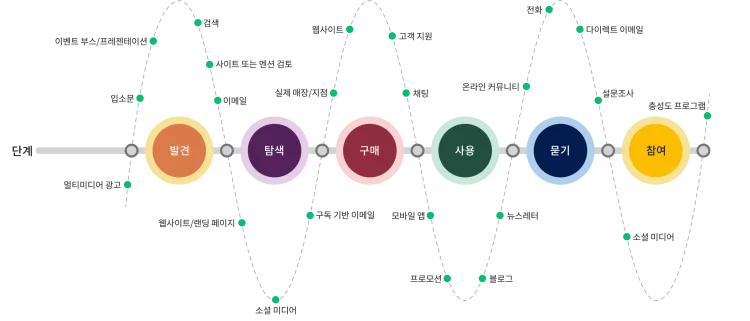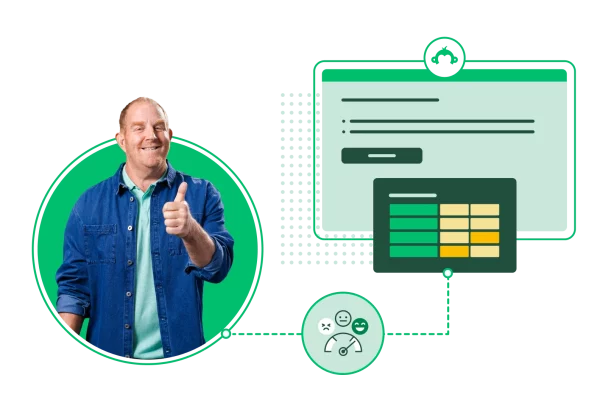판매를 개선하고 브랜드를 구축하고 싶다면 기업가보다는 고객처럼 생각해야 합니다. 왜일까요? 훌륭한 제품, 멋진 웹사이트, 신속한 배달, 헌신적인 고객 서비스 팀을 보유하고 있을 수 있습니다. 하지만 고객 여정에 어떤 문제든 발생하면 잠재 고객을 잃을 수 있기 때문입니다.
이 과정을 어떻게 개선할까요? 고객처럼 생각하며 고객 여정을 구상하면 첫 접촉에서 구매 후 교류까지 고객 접점을 따라가며 확인하는 데 도움이 될 수 있습니다. 고객 접점을 파악하고 개선하면 고객 경험(CX)이 향상되어 만족도와 충성도가 높은 고객 층으로 이어집니다.
최고의 가이드에서 고객 여정에 대해 알아보세요. 고객 여정이 무엇이고 이를 파악하는 방법과 매출 증대에 활용하는 방법을 알아보세요.
고객 여정이란
고객 여정은 고객 수명 주기 동안 구매자가 브랜드와 상호작용하는 일련의 과정입니다. 이는 고객이 브랜드와 가지는 첫 접점부터 시작해서 유지 단계까지 이어집니다.
대상 그룹의 고객 여정에 대한 인사이트를 확보하면 고객 여정을 최적화하여 만족스러운 고객 경험을 보장할 수 있습니다. 89%의 CX 전문가들이 고객 이탈의 주요 원인이 고객 경험이라고 믿는 것을 고려하면 이를 개선하는 일이 무엇보다 중요합니다.
고객 여정을 단일 개념으로 생각할 수 있지만, 이를 구성하는 9개의 뚜렷한 단계가 있습니다.
고객 여정 단계
신규 고객은 브랜드에 대해 오래된 기존 고객과는 다르게 느낄 수 있습니다. 고객 여정의 각 단계를 알면 회사가 각 단계에서 고객과 소통하는 데 도움이 됩니다.
고객 여정의 각 단계를 살펴보고 해당 시점에 고객이 회사와 어떤 식으로 교류하는지 알아보겠습니다.
인지
고객 여정의 첫 번째 단계는 인지입니다. 인지 단계에서는 고객이 처음으로 브랜드를 접하게 됩니다. 고객이 회사에 대해 잘 모를 수도 있지만 회사가 제공하는 것에 대해 자세히 알아보고 싶습니다.
고객이 브랜드를 접할 수 있는 여러 가지 방법이 있습니다.
- 스크롤 중 소셜 미디어 게시물 보기
- Google 검색의 블로그 게시물 클릭하기
- 회사가 게시한 자료 읽기
- 제품 중 하나에 대한 광고 보기
고려
고객 여정의 두 번째 단계는 고려입니다. 고려 단계에서는 고객이 이미 콘텐츠를 경험했고 회사에서 제공하는 것들에 대해 읽었을 수 있습니다. 보통 경쟁사와 어떻게 비교되는지, 제품이나 서비스가 독특한지 알아보고 싶어 합니다.
고려 단계에서는 고객을 다음과 같이 정의합니다.
- 제품에 호기심이 있음
- 더 자세히 알아보고 싶어 함
- 친구로부터 추천을 받거나 다른 광고를 본 후 더 조사하고 싶음
관심
고객 여정의 세 번째 단계는 관심입니다. 관심 단계에서는 잠재 고객이 철저한 조사를 합니다. 잠재 고객이 제품 설명을 자세히 읽고 제품 데모에 참여할 수도 있습니다.
관심 단계의 고객은 다음과 같이 할 것입니다.
- 제품에 완전 몰두
- 제공되는 서비스에 대한 자세한 정보 요청
- 서비스 및 제품의 후기 읽기
의도
고객 여정의 네 번째 단계는 의도입니다. 의도 단계에서는 고객이 제품 및 서비스를 사용해 보기로 결정합니다. 질문하거나 지원 요청이 필요한 잠재적인 문제점을 찾을 수도 있습니다.
고객 여정의 의도 단계에 있는 고객은 다음과 같은 행동을 할 수 있습니다.
- 영업 데모 요청
- 영업 담당자에게 연락
- 견적 요청
- 장바구니에 제품 추가
구매
고객 여정의 다섯 번째 단계는 구매입니다. 구매 단계에서는 고객이 회사와 거래하기로 확정합니다. 구매는 리드를 유료 고객으로 전환하는 첫 번째 거래 접점입니다.
고객 여정의 이 단계는 모든 이전 조사의 산물입니다. 이 단계의 고객은 다음의 행동을 할 것입니다.
- 웹사이트에서 구매
- 현지 매장을 방문하여 제품 구매
- 서비스를 구매하거나 체험에 참여
구매 후
고객 여정의 여섯 번째 단계는 구매 후입니다. 구매 후 단계에서는 고객이 처음으로 제품 및 서비스를 사용하게 됩니다. 제공하는 제품 및 서비스의 품질을 평가하고 기대치에 부합하는지 확인하게 됩니다.
회사는 구매 후 단계에서 다음과 같은 방법으로 고객과 교류할 수 있습니다.
- 제품이나 서비스 사용법에 대한 안내나 튜토리얼 제공
- 고객에게 도움이 필요한 경우 고객 서비스 팀을 통해 지원
- 고객 설문조사를 보내 제공하는 제품 및 서비스에 대한 만족도 모니터링
유지
고객 여정의 일곱 번째 단계는 유지입니다. 유지 단계에서는 고객과의 관계를 강화하는 데 집중합니다. 충성도와 브랜드에 대한 만족도를 높이는 것을 목표로 합니다.
이 단계에서 고객의 상황은 보통 다음과 같습니다.
- 회사 제품이나 서비스를 최소한 한 번 이상 구매함
- 고객 충성도 프로그램이나 포인트 제도에 참여할 수 있음
- 회사로부터 맞춤 특가 제공을 받음
애드보커시
고객 여정의 여덟 번째 단계는 애드보커시입니다. 애드보커시 단계에서는 고객이 회사 제품을 능숙하게 잘 사용합니다. 제품에 대한 만족도가 높아 친구와 가족에서 회사를 적극 홍보합니다.
고객 여정의 애드보커시 단계에 있는 고객은 다음과 같은 행동을 합니다.
- 제품의 온라인 후기 남기기
- 소셜 미디어 게시물을 통해 제품을 공개적으로 지지
- 제품 및 서비스를 친구, 가족 및 동료에게 추천
충성도
고객 여정의 마지막 아홉 번째 단계는 충성입니다. 가장 만족한 고객에게 해당되며 지속적으로 유지되는 고객 여정의 최종 단계입니다. 이 시점에서 고객은 제품 및 서비스에 매우 만족하며 회사의 충성 고객이 되기로 결정했습니다.
고객 여정의 이 최종 단계에 있는 고객은 다음과 같은 행동을 합니다.
- 제품과 서비스에 매우 만족하며 모든 지인에게 추천
- 종종 수년에 걸친 기간 동안 제품을 반복적으로 구매
- 이용 가능한 충성도 프로그램에 적극 참여
- 회사로부터 고도로 맞춤화된 마케팅 자료, 특가, 선물 받기
고객 여정 매핑이란
고객 여정 매핑은 고객 접점을 시각적으로 나타낸 것입니다. 다음은 이에 대한 예시입니다.

고객 접점은 고객이 회사의 브랜드를 접하는 모든 순간을 말합니다. 광고 등을 통해 처음 접하는 순간부터 진지한 고객이 된 후 충성도 프로그램에 참여할 때까지 이어집니다.
여정 지도 전체에서 가장 중요한 고객 접점을 파악하여 각 시점을 최적화할 수 있습니다. 고객 접점을 개선하면 원활한 고객 경험을 제공하여 고객 만족도가 향상됩니다.
고객 여정 매핑의 이점
고객 여정 매핑을 통해 고객 여정을 완전히 파악할 수 있습니다. 고객 여정 매핑에는 다음과 같은 다양한 이점이 있습니다.
- 고객 접점 마찰 감소: 특정 접점에서 좋지 않은 경험을 한 고객들은 회사와 교류하는 것을 꺼릴 수 있습니다. 고객 접점을 매핑하고 모니터링하면 고객 여정에서 발생할 수 있는 문제를 개선하는 데 도움이 될 수 있습니다.
- 유지율 개선: 후반 단계의 고객 접점을 필요에 따라 개선하면 고객이 느끼는 만족도가 더 높아집니다. 이를 통해 고객 유지율을 높이고 고객 이탈률을 낮출 수 있습니다.
- CX 강화: 고객 경험은 고객이 브랜드와 교류하는 방법을 정의합니다. 고객 여정을 매핑하면 이러한 교류에서 일어나는 모든 활동을 개선하여 고객을 지속적으로 만족시킬 수 있습니다.
- 판매 촉진: 브랜드에 대한 만족도가 높은 고객은 재구매 가능성이 더 높습니다. 고객 접점을 개선하면 판매를 증대하고 수익을 높일 수 있습니다.
- 고객 충성도 향상: 고객의 필요를 기대 이상으로 맞추면 충성도가 더 높아질 것입니다.
고객 여정 지도를 만들면 고객과의 모든 교류를 더 잘 이해할 수 있습니다. 고객 만족도 지표로 각 접점을 모니터링하면 고객 경험을 개선하고 고객 만족도를 높이는 데 도움이 됩니다.
고객 여정 매핑 방법: 단계별 가이드

고객 여정을 매핑하면 회사와 고객의 모든 교류를 개선하고 간소화할 수 있습니다. 고객 여정을 개선하는 회사는 고객들에게 훌륭한 고객 경험을 제공하여 만족도와 충성도를 높일 수 있습니다.
다음은 고객 여정을 매핑하는 방법으로 반드시 알아야 할 모든 중요한 단계를 다루고 있습니다.
고객 여정 지도의 목표 설정
목표는 고객 여정 매핑에 매우 중요합니다. 목표가 확실하지 않으면 결국 여정을 매핑할 수 없습니다.
고객 여정 지도의 목표에 따라 사용할 구조와 전략이 달라집니다. 몇 가지 목표를 예로 살펴보겠습니다.
- 고객 유지율 개선: 이 목표의 경우 고객 여정에서 고객의 문제점을 파악하고 시간이 지나면서 그러한 문제점을 완화하는 것이 주요 목표임을 알 수 있습니다.
- 전환율 증가: 판매를 늘리고 싶은 경우에는 고객 여정 지도가 전환율을 높이고 고려 및 관심 단계를 개선하기 위한 데이터 지향 전략에 초점을 맞출 것입니다.
- 제품 개선: 현재 제품을 개선하고 싶은 경우에는 고객 여정 지도에 구매 후 피드백 또는 제품 피드백 설문조사와 데이터 수집 개선을 포함할 수 있습니다.
어디서부터 시작해야 할지 잘 모르겠다면 먼저 고객을 살펴보세요. 설문조사를 통해 고객 데이터를 수집하거나 시장 조사를 수행하면 개선이 필요한 영역을 파악할 수 있을 것입니다.
CX 우선 순위와 목표의 목록을 만들었다면 다음 단계로 넘어갈 차례입니다.
고객 페르소나 만들기
고객 페르소나에는 타겟팅하는 대상 그룹의 하위 섹션을 대표하는 상세한 고객 프로필을 만드는 작업이 포함됩니다. 고객 페르소나마다 눈에 띄는 각기 다른 문제점이나 특성이 있을 수 있습니다.
이러한 세그먼트 각각에 맞게 고객 여정 지도를 조정하여 더욱 종합적인 계획을 세울 수 있습니다. 다음은 고객 페르소나를 만드는 단계별 가이드입니다.
- 고객 데이터 수집: 설문조사를 사용하여 고객 데이터를 수집할 수 있습니다. 제품 및 서비스에 대한 인구 통계, 만족도 및 고객 경험에 대한 질문을 하세요.
- 수집 및 분석: 데이터를 수집한 다음 통계 분석을 수행하여 고객 데이터 전반에 걸쳐 추세, 패턴 및 중요한 테마를 파악하세요.
- 데이터 세분화: 인구 통계 정보를 기반으로 다양한 고객 그룹 간의 추세를 발견할 수 있습니다.
- 페르소나 만들기: 인구 통계 데이터를 기반으로 고객 프로필을 만듭니다. 각 그룹의 과제, 동기, 선호하는 소통 방법 및 목표를 포함하세요.
- 그룹 확인: 이러한 고객 프로필을 시작하기 전에 반드시 내부 데이터와 비교하여 그룹을 다시 확인하세요. 고객이나 포커스 그룹의 데이터를 사용하여 비즈니스에 더 적합하게 고객 페르소나를 업데이트할 수 있습니다.
설문조사는 조사하려는 고객 경험의 다양한 부분에 대한 정보를 수집하는 훌륭한 방법으로 고객 만족도에서 충성도에 이르기까지 모든 것에 대한 인사이트를 제공합니다.
설문조사를 사용하여 효과적인 고객 페르소나를 만들기 위한 데이터의 토대를 마련할 수 있습니다.
고객 접점 파악
고객 접점을 파악하는 가장 좋은 방법은 고객처럼 생각하는 것입니다. 이들이 브랜드와 처음 접한 순간부터 거치게 될 과정을 생각해 보세요.
고객 여정 지도 전반에 걸쳐 가장 일반적인 고객 접점 몇 가지를 그려보세요.
- 거래 전: 광고, 온라인 사용후기 또는 소셜 미디어 활동과 같은 마케팅 노력 중 하나일 수 있습니다. 전자 상거래 사이트에 올린 제품 후기나 입소문을 통해 고객의 브랜드에 대한 인상이 형성될 수도 있습니다.
- 거래 중: 실제 매장, 웹사이트 또는 카탈로그를 통해 판매가 이루어질 수 있습니다. 고객은 이러한 접점에서 직원, 영업 팀 또는 콜 센터와 교류할 수 있습니다.
- 거래 후: 이러한 접점에는 청구, 제품 지원, 질문 및 반품이 포함됩니다. 고객 피드백 설문조사, 제품 뉴스레터 또는 감사 카드를 보낼 수 있습니다.
고객 여정에서 접점을 매핑한 후, 이러한 접점이 서로 잘 맞는지 지켜보세요. 고객이 도중에 경험할 수 있는 어떤 장애가 있나요? 누락되거나 제대로 다루지 않은 접점이 있나요?
고객의 목소리(VOC) 프로그램을 만들면 모든 접점에서 고객 경험을 이해하는 데 도움이 됩니다. Net Promoter® Score(NPS), 고객 만족도(CSAT) 및 고객 노력 점수(CES) 설문조사로 고객 피드백을 수집하여 고객 경험(CX)을 조정하는 데 필요한 인사이트를 얻을 수 있습니다.
고객 여정 매핑의 모범 사례
고객 여정 매핑은 특히 확장 중인 사업체나 기업의 경우 복잡해질 수 있습니다. 다음은 고객 여정 지도를 효과적으로 만들기 위한 모범 사례입니다.
고객 여정 매핑 템플릿 활용
회사마다 제공하는 고객 여정이 다르지만 모든 지도는 보통 비슷한 단계를 거치게 됩니다. 이를 염두에 두고 템플릿을 활용하면 고객 여정 지도를 만드는 데 걸리는 시간을 줄일 수 있습니다.
먼저 고객 여정의 각 단계를 적어보세요. 그런 다음 각 단계에 일반적인 접점을 채울 수 있습니다. 마지막으로 컨텍스트를 더 추가하여 비즈니스에 적합하게 이 템플릿를 맞춤화할 수 있습니다.
고객 여정 지도 템플릿을 사용하면 고객 여정 과정을 더 쉽고, 빠르고, 효율적으로 확인해 나갈 수 있습니다.
설문조사를 사용하여 고객 접점을 매핑
많은 잠재적 고객 접점이 있습니다. 어떤 비즈니스에는 수백 개의 접점이 있고, 또 다른 어떤 비즈니스에는 수천 개의 접점이 있을 수 있습니다. 설문조사는 이러한 모든 고객 접점에서 데이터를 수집하는 가장 좋은 방법입니다.
설문조사는 다음과 같은 특징이 있어 효과적입니다.
- 신속하게 개발 가능
- 정량적 및 정성적 데이터를 모두 신속하게 수집
- 질문을 맞춤화할 수 있는 유연성 제공
설문조사는 꼭 필요한 계층의 로직과 데이터를 제공합니다. 각 주요 고객 접점에서 설문조사를 사용하면 문제를 파악하여 효율적으로 해결할 수 있습니다.
모든 접점에서 피드백 수집

모든 접점에서 피드백을 수집하면 고객 여정의 종합적인 개요가 제공됩니다. 설문조사 자동화는 각 접점에서 정보를 확보하는 효과적인 방법입니다.
고객이 중요한 접점에서 교류할 때마다 접점 설문조사가 실행되게 할 수 있습니다. 예를 들어 고객 지원 팀과 교류할 때에는 고객 지원 만족도 설문조사가 실행되어 팀이 고객에게 도움이 되었는지 알아 볼 수 있습니다.
피드백을 많이 확보할수록 조치를 취하고 고객 경험을 개선하는 데 필요한 정보를 더 많이 갖추게 됩니다.
고객 여정 지도에서 고객의 필요를 먼저 생각하세요
우수한 제품, 동적 장바구니 또는 최고 수준의 고객 지원팀이 있더라도 고객이 이용에 어려움을 겪는다면 별로 쓸모가 없을 것입니다. 고객 여정에서 마찰을 해결하면 고객 만족도와 고객 충성도가 높아질 것입니다.
고객 여정 경험을 개선하고 싶으세요? SurveyMonkey 고객 경험 관리 소프트웨어를 사용하여 고객 경험 향상을 위한 노력과 활동을 확장하고 필요한 모든 곳에서 피드백을 받아보세요.
Net Promoter, Net Promoter Score 및 NPS는 Satmetrix Systems, Inc., Bain & Company, Inc. 및 Fred Reichheld의 상표입니다.
리소스 더 살펴보기

고객 만족도 설문조사 템플릿
SurveyMonkey의 고객 만족도 설문조사 템플릿을 살펴보고 신속하게 데이터를 수집하고, 문제점을 파악하며, 고객 경험을 개선하세요.

Ryanair가 어떻게 대규모 고객 인사이트를 수집하는지 알아보세요
Ryanair가 SurveyMonkey와 Microsoft Power BI 연동 서비스를 사용하여 어떻게 월 50만 개의 CSAT 설문조사 응답을 추적하고 고객 경험을 개선하는지 알아보세요.

woom이 직원과 고객 경험을 어떻게 향상하는지 알아보세요
woom이 어떻게 SurveyMonkey를 활용해 다국어 설문조사를 규모에 맞추어 실행하고, 직원 경험을 개선하며, 고객 인사이트를 얻는지 알아보세요.

Together Labs가 사용자 인사이트를 확보하는 데 SurveyMonkey를 사용하는 이유를 확인하세요
Together Labs가 심층적인 사용자 피드백을 수집하기 위해 Google Forms 사용을 중단하고 SurveyMonkey Enterprise로 업그레이드한 이유를 알아보세요.
